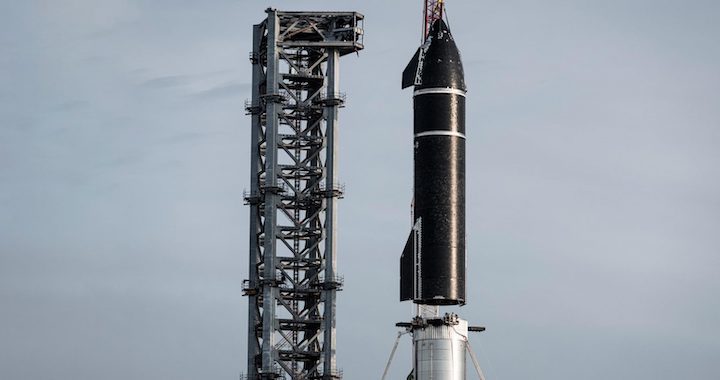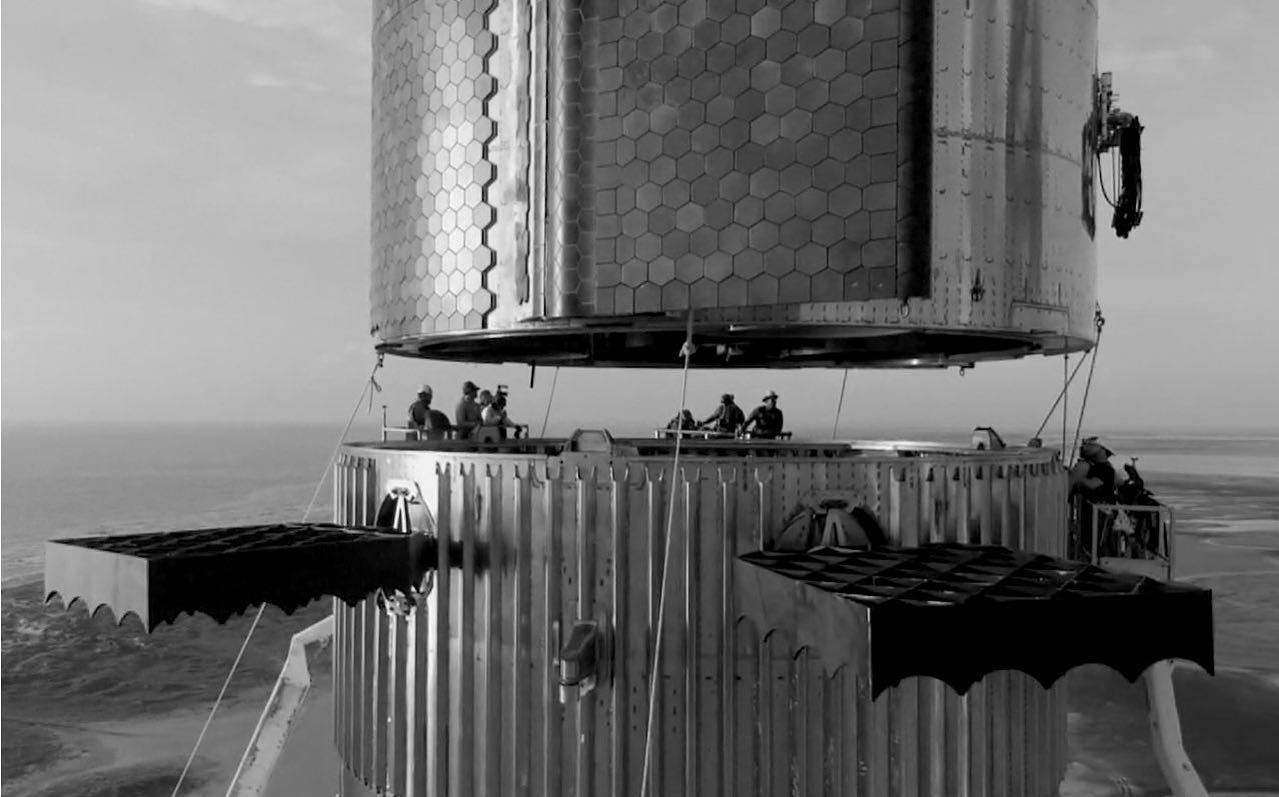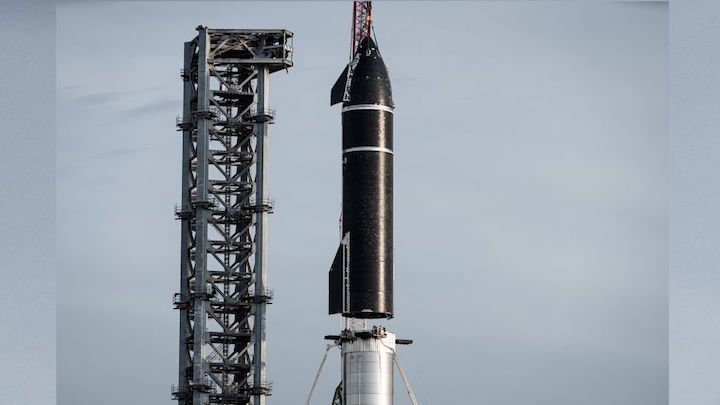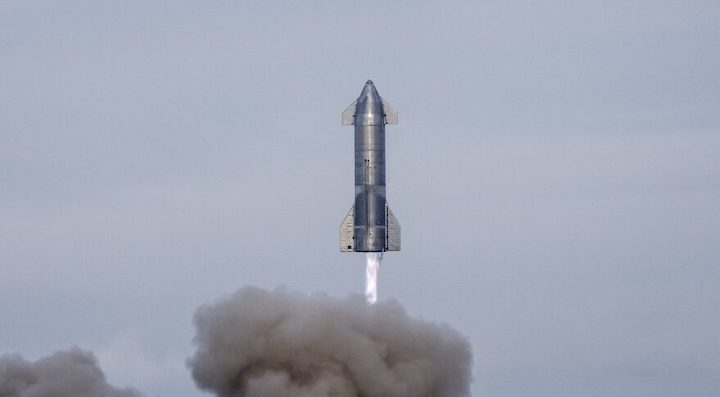9.08.2021
SpaceX Starship briefly becomes largest rocket in history – now what’s next?

On August 6th, after a great deal of anticipation, SpaceX stacked a Starship on top of a Super Heavy booster for the first time ever, very briefly assembling the largest rocket in history.
However, barely an hour after the two stages were integrated and (presumably) latched together, SpaceX lifted Starship (S20) off the booster, returned it to its transport stand, and rolled the ship back to the build site later that day. Though an extreme sensitivity to wind conditions has delayed the procedure, Super Heavy Booster 4 (B4) also appears to be on track to be removed from the orbital launch mount and sent either back to the factory or to a suborbital launch mount that’s been modified for booster testing.
For those that followed the process closely in the days and weeks prior, the fact that Starship’s first full assembly was just a fit check (and, really, more like 50:50 between fit check and photo op) came as no surprise. In the lead-up, it became clear through several reports that CEO Elon Musk had challenged SpaceX to stack Ship 20 and Booster 4 by August 5th and flown in several hundred employees normally stationed elsewhere to accomplish the feat.
Ignoring weather delays that prevented stacking on August 5th, SpaceX met Musk’s challenge in all but the literal sense, assembling the world’s largest rocket into one integrated stack for the first time ever. Even more significantly, despite the fact that SpaceX could have easily decided to stack two not-for-flight prototypes to sort of achieve the same feat, both stages – Ship 20 and Booster 4 – involved in the August 6th milestone are nominally destined for flight.
Barring surprises, the same exact pair is scheduled to support Starship’s first orbital test flight as early as this year. Before they can be cleared for flight, however, a great deal of work must still be completed – work that in some cases is unprecedented in the history of the Starship program.
Not long after the stacking milestone, Musk himself sketched out a few of the tasks still in front of the rocket. Namely, Musk says that SpaceX must still complete Starship S20’s partially-finished heat shield, install some form of heat shield(s) to protect Super Heavy Booster 4’s 29 naked Raptor engines; finish installing, plumbing, and activating 4-7 massive custom propellant storage tanks; and assemble, install, and activate a giant mechanical umbilical arm on the launch tower to fuel and power Starship.
All are undoubtedly crucial and Starship is unlikely to launch before any of them are more or less complete. However, the booster and ship themselves are arguably far more of a pressure point. Before they can be deemed ready for flight, both the ship and booster must complete unprecedented test campaigns on the ground.
Ship 20 will need to complete cryogenic proof testing to verify that the first Starship with six Raptor engine mounts is structurally sound. SpaceX has already modified one of its two suborbital Starship launch mounts for that purpose. Once cryo proof and hydraulic ram testing is complete, those six rams will likely be removed and six Raptor engines will be installed in their place, potentially setting up Ship 20 to become the first Starship prototype to static fire six engines – and any number of Raptor Vacuum engines.
Super Heavy Booster 4 will be faced with an even more ambitious static fire test campaign as SpaceX likely gradually installs more and more engines. Depending on how focused SpaceX is on speed over thoroughness, that process could involve gradually adding 2-5 engines after every static fire or could result in SpaceX starting with 4-9 engines and then immediately jumping from 9 to a full 29-Raptor static fire.
Only after completing those crucial qualification tests is SpaceX likely to stack Ship 20 and Booster 4 for a second time and enter the first true full-stack Starship launch flow – hopefully culminating in the first orbital launch attempt later this year, but only as soon as the FAA completes an environmental review and approves the rocket’s launch license. Technically, FAA approval could come tomorrow or it could take the agency a year or more – it’s almost impossible to predict without official information. However, given SpaceX’s track record with Starship prototypes and Booster B3, it’s likely that a flightworthy Starship and Super Heavy will be stacked on the pad and ready to launch just a few months from now.
Stay tuned for updates on that potential standoff in the making and Starship’s progress towards its first orbital test flight.


Quelle: SpaceX, TESLARATI
----
Update: 19.08.2021
.
SpaceX's Starship could be ready for 1st orbital test flight 'in a few weeks,' Elon Musk says
But don't expect it to actually launch so soon.

SpaceX's first orbital Starship SN20 is stacked atop its massive Super Heavy Booster 4 for the first time on Aug. 6, 2021 at the company's Starbase facility near Boca Chica Village in South Texas. The duo stood 395 feet tall, taller than NASA's Saturn V moon rocket. (Image credit: SpaceX)
The biggest rocket ever built may be ready to fly surprisingly soon.
The first full-size prototype of SpaceX's Starship vehicle should be ready to launch on an orbital test flight "in a few weeks," company founder and CEO Elon Musk said via Twitter on Saturday (Aug. 14).
That target seems very soon, given that SpaceX has yet to run the 395-foot-tall (120 meters) rocket through its usual battery of preflight tests. And there's a big logistical hurdle to overcome as well: The U.S. Federal Aviation Administration (FAA) is conducting an environmental assessment of SpaceX's South Texas orbital launch site, where Starship will lift off.
The FAA has not yet released its draft review, and the agency will accept public comments about the report for 30 days after it comes out. So Starship's orbital jaunt cannot feasibly happen just a few weeks from now — a reality that Musk acknowledged in his Saturday tweet, which ended with the words "pending regulatory approval."
In fact, Musk's tweet may have been designed to put a little pressure on the FAA to pick up the pace. After all, he has expressed frustration with FAA regulationsin the past, stressing that such rules need to be streamlined if humanity is ever going to achieve game-changing launch frequencies.
And SpaceX intends Starship to be a game changer. The vehicle, which consists of a huge first-stage booster known as Super Heavy and a spacecraft called Starship, is designed to take people and cargo to the moon, Mars and other distant destinations.
SpaceX has conducted test flights of previous Starship prototypes, sending the spacecraft 6.2 miles (10 kilometers) into the sky from the South Texas site, which is near the Gulf Coast village of Boca Chica. But the upcoming test flight will mark the first time a fully stacked Starship — a Super Heavy topped with a Starship spacecraft — takes flight, and the first time the system reaches orbit.
If all goes according to plan, Super Heavy will splash down in the Gulf of Mexico shortly after liftoff. Starship, meanwhile, will power its way to orbit, loop around our planet once and come down in the Pacific Ocean, near the Hawaiian island of Kauai.
SpaceX has already taken some steps toward this landmark flight. On Aug. 6, for example, the company stacked the two Starship components — a 29-engine Super Heavy called Booster 4 and a six-engine Starship prototype known as SN20 — atop the South Texas orbital launch mount for the first time ever. But the duo was de-stacked later that day so technicians could perform some more work on each element.
Quelle: SC
----
Update: 21.08.2021
.
SpaceX wants to give Starship lead role in revised second-gen Starlink plan

TAMPA, Fla. — SpaceX is proposing to use Starship to rapidly deploy its second-generation Starlink constellation, providing denser rural coverage without needing more than the 30,000 satellites it previously envisioned for the follow-on network.
The proposal is one of two revised configurations that SpaceX filed Aug. 18 with the Federal Communications Commission for Starlink Gen2, updating a plan submitted in 2020.
The other configuration envisages continuing to use Falcon 9 rockets for launching Starlink satellites, and also does not involve a larger constellation or require more spectrum than what SpaceX outlined last year.
Instead, the revised scenarios for Starlink Gen2 aim to spread satellites more evenly across nine to 12 inclined orbits to provide denser polar coverage for rural subscribers, as well as national security and first responder customers, to make the network’s performance more consistent.
SpaceX said it prefers the configuration that uses its heavy-lift Starship rocket because it would allow satellites to enter service “within a matter of weeks after launch, rather than months.” The company recently accelerated work at its Starbase test site in Boca Chica, Texas, to prepare for Starship’s first orbital flight.
The Starship-enabled Starlink configuration comprises 29,988 satellites at altitudes of between 340 and 614 kilometers, across nine inclined orbits.
“By targeting multiple inclinations, these revised orbital parameters will more evenly distribute capacity by latitude ensuring better, more consistent global coverage,” SpaceX said in an FCC filing.
“SpaceX will also nearly double the number of satellites deployed in sun-synchronous orbit optimized for key throughput demand times and service to polar regions like Alaska, resulting in additional capacity for those chronically underserved areas.
“The revised orbital planes enable ‘direct to station’ launch campaigns that capitalize on the ability of Starship to deliver satellites at a faster pace.”
The Falcon 9-launched configuration would spread 29,996 satellites across 12 orbital inclinations at altitudes between 328 and 614 kilometers altitude.
Although the Gen2 satellites will be “somewhat larger and generate more power than originally contemplated,” SpaceX said its analysis shows they would not interfere with other constellations, or increase the risk of debris-causing collisions in space.
As with the more than 1,600 Starlink satellites SpaceX currently operates in low Earth orbit at an altitude of around 550 kilometers, Gen2 spacecraft will rely on collision-avoidance software and on-board propulsion to mitigate debris threats.
The increasingly crowded space environment is a growing concern for businesses and regulators worldwide, as a rising number of megaconstellations plan to deploy thousands more LEO satellites in the coming years.
Satellite broadband operator Viasat has launched legal action against SpaceX in an attempt to compel an environmental review into its Starlink expansion plans.
“As the Commission has recognized, because SpaceX has invested in advanced propulsion capabilities for its satellites, collision risk with large objects is considered to be zero while the spacecraft are capable of maneuvering,” SpaceX said in the FCC filing.
“While SpaceX expects its satellites to perform nominally and deorbit actively, in the unlikely event a vehicle is unable to finish its planned disposal maneuver, the denser atmospheric conditions at the low altitudes proposed herein for use by the Gen2 System provide fully passive redundancy to SpaceX’s active disposal procedures.”
Even in a “worst-case scenario” where a Starlink satellite loses maneuverability and attitude control in operational orbit, a satellite in either proposed Gen2 configuration would reenter the atmosphere within four years and burn up.
At lower altitudes than satellites in the first-generation Starlink constellation and other megaconstellations including OneWeb, Gen2 spacecraft would spend less time illuminated by the sun, posing less of a reflection problem for astronomers.
SpaceX is asking the FCC for waivers to proceed with either configuration.
One of the waivers concerns power flux density Ka-band downlink limits set by the International Telecommunication Union (ITU).
These limits rely on flawed calculations, according to SpaceX, because they were devised without the capability to scale up for non-geostationary constellations with more than 840 satellites.
The FCC had told SpaceX to get a “favorable” or “qualified favorable” finding from the ITU on its equivalent power flux-density (EPFD) limits before initiating services.
“Given the volume of pending EPFD filings, the ITU is unlikely to complete its evaluation of the Gen2 System and render an EPFD finding on a time frame that will match SpaceX’s aggressive constellation deployment schedule,” SpaceX said in a related FCC filing.
Without a waiver from the FCC, SpaceX warned it “would have to postpone providing the more capable and efficient service contemplated under this new constellation until the ITU completes its analysis, with many gigahertz of valuable spectrum remaining underutilized in the interim.”
Quelle: SN
----
Update: 24.08.2021
.
SpaceX Starship factory breaks ground on an even bigger ‘high bay’
SpaceX appears to have more or less broken ground on a new, even bigger ‘high bay’ assembly facility at its Boca Chica, Texas Starship factory.
Barely one year ago, SpaceX erected the first prefabricated steel sections of what eventually become its Starship factory ‘high bay’ – a spartan 81m (~265 ft) tall designed at the most basic level to shield final Starship and Super Heavy booster assembly from the elements. Situated near the southernmost tip of Texas and just a few miles west of the Gulf of Mexico, those “elements” can be less than pleasant at SpaceX’s primary Starship factory, ranging from sauna-like heat and humidity and mosquitoes the size of quarters to regular downpours, thunderstorms, tropical conditions, and even hurricanes.
While a great deal of work at Starbase is still done out in the open with little more than an umbrella as protection, SpaceX has nevertheless worked to find a middle ground where the most sensitive work (mainly structural welding) can be mostly shielded from wind and rain. First, SpaceX built a (relatively) tiny ‘windbreak’ too small for much of anything. Two years later, the windbreak is partially used for Starship nose section assembly – when a nose cone is stacked on and welded to a separate stack of four steel rings.
A few months after the triangular windbreak was fully finished, SpaceX started work on a larger box-like building that would eventually be known as the Starship factory’s ‘midbay.’ Standing around 45m (~150 ft) tall, the midbay was designed to support the process of assembling Starship tank sections from several stacks of 2-4 steel rings but was – for whatever reason – left too short to support the full Starship assembly process.
Instead, once Starship tank sections were finished, they would have to be rolled out of the midbay for nose installation. Eventually, in July 2020, SpaceX began assembling an even larger ‘high bay’ that would ultimately measure 81m (~265 ft) tall and 20-25m (65-80 ft) wide and deep – easily big enough to fit the company’s existing Falcon 9 or Falcon Heavy rockets with room to spare. More importantly, of course, the high bay was built to be large enough to support Super Heavy assembly from start to finish, giving SpaceX teams a sheltered place to build the largest rocket boosters in history.
As of August 2021, SpaceX’s midbay has supported the assembly of 10 Starship prototypes, 5-6 propellant storage tanks, and several ‘test tanks,’ while the newer high bay has helped SpaceX build three (mostly) complete Super Heavy boosters in 2021. However, working at full speed, SpaceX’s midbay is really only capable of supporting the assembly of one Starship tank section (and more general work on two) at a time and the high bay – while offering at least twice the covered surface area – appears to be limited to simultaneous work on two or three different stacks (boosters, ships, tanks, etc.).
As SpaceX slowly but surely treks towards the end of approximately two years almost exclusively dedicated to building ever-changing prototypes, it’s been clear for a while that the company would need to drastically expand its production facilities to produce the dozens of Starships and boosters CEO Elon Musk has been publicly dreaming of. Even at lower volumes, those existing facilities – while great for producing a dozen or more prototypes per year – would still become a chokepoint for the near-term production of a small fleet of operational Starships and Super Heavies.
In turn, Musk revealed that SpaceX was about to start building “a much larger high bay” adjacent to the existing structure in late July. On August 20th, a little over a year after assembly of the original high bay kicked off, SpaceX began the process of tearing up existing concrete for the even larger bay – breaking ground, at least in a sense. According to Musk, the newest addition to Starbase’s Starship factory will be about 10% taller (~90m vs 81m), substantially wider, and likely a bit deeper than the existing high bay, allowing for the installation of two side-by-side bridge cranes with tracks running the full width of the building.
With at least 2-3 times more surface area than the high bay, the new wide bay should give SpaceX enough space to simultaneously assemble something like 4-8 Starships or Super Heavy boosters. Depending on which direction SpaceX goes, the wide bay could also potentially be large enough for SpaceX to create the first true Starship and Super Heavy assembly lines, though that would be a substantial departure from Starbase’s existing approach to manufacturing.
Quelle: TESLARATI
